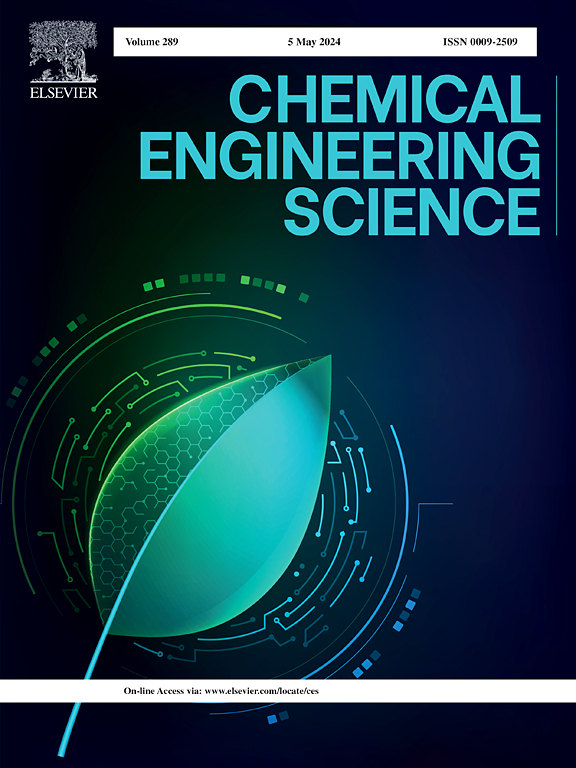Identification of flow regime in a co-current upflow packed bed reactor (U-PBR) using gamma-ray densitometry (GRD)
IF 4.1
2区 工程技术
Q2 ENGINEERING, CHEMICAL
引用次数: 0
Abstract
Owing to their significant impact on the reaction rate, the comprehensive understanding of the hydrodynamics in any novel design of the Upflow Packed Bed Reactor (U-PBR) is essential for the optimization of its throughput. In this regard, the identification of the flow regime is of paramount importance. Therefore, in this work, we use the photon counts time-series data obtained using the non-invasive Gamma-ray densitometry (GRD) to identify, for the first time, the flow regimes and their transition velocities at two axial locations () and five radial locations () within the packed catalysts’ bed of U-PBR with a novel plenum design consisting of five deflectors. The photon counts, which were obtained for a wide range of superficial inlet gas velocities () and superficial inlet liquid velocities (), were analyzed using the Kolmogorov Entropy (KE) method and the Standard Deviation method. Using these two methods, three flow regimes (bubble, pulse, and spray) as well as transient phases were identified at the center of the reactor (r/R = 0) at varying superficial inlet gas and liquid velocities depending on the axial location. At most other radial location, owing to more significant pressure drop, only two flow regimes are identified. Furthermore, the transition velocities were more distinctly identified using the KE method, compared to the standard deviation. These transition velocities were also found to vary significantly depending on the void fraction which substantially affects the liquid and gas distribution and mixing, as well as the local gas and liquid velocities.用伽玛射线密度法(GRD)识别共流上流式填料床反应器(U-PBR)的流态
由于流体动力学对反应速率有重要影响,因此在任何新型的上流填料床反应器(U-PBR)设计中,全面了解流体动力学对于优化其吞吐量至关重要。在这方面,确定流动型态是至关重要的。因此,在这项工作中,我们首次使用无创伽玛射线密度测量(GRD)获得的光子计数时间序列数据,确定了U-PBR填充催化剂床内两个轴向位置(Z/D=0.8,1.56Z/D=0.8,1.56)和五个径向位置(r/ r =0,±0.5,±0.9r/ r =0,±0.5,±0.9)的流动形式及其过渡速度。利用Kolmogorov熵(KE)法和标准偏差法分析了在较宽的入口气速(0.06 ~ 9.6cm/s0.06 ~ 9.6cm/s)和入口液速(0.003 ~ 0.021cm/s0.003 ~ 0.021cm/s)范围内的光子计数。使用这两种方法,在反应器中心(r/ r = 0)确定了三种流动形式(气泡、脉冲和喷雾)以及瞬态相,这些流动形式取决于轴向位置,在不同的表面进口气液速度下。在大多数其他径向位置,由于压降更大,只能识别两种流动形式。此外,与标准差相比,用KE方法可以更清楚地识别过渡速度。研究还发现,这些过渡速度的变化很大程度上取决于空隙率,空隙率对液气分布和混合以及局部气液速度的影响。
本文章由计算机程序翻译,如有差异,请以英文原文为准。
求助全文
约1分钟内获得全文
求助全文
来源期刊

Chemical Engineering Science
工程技术-工程:化工
CiteScore
7.50
自引率
8.50%
发文量
1025
审稿时长
50 days
期刊介绍:
Chemical engineering enables the transformation of natural resources and energy into useful products for society. It draws on and applies natural sciences, mathematics and economics, and has developed fundamental engineering science that underpins the discipline.
Chemical Engineering Science (CES) has been publishing papers on the fundamentals of chemical engineering since 1951. CES is the platform where the most significant advances in the discipline have ever since been published. Chemical Engineering Science has accompanied and sustained chemical engineering through its development into the vibrant and broad scientific discipline it is today.
 求助内容:
求助内容: 应助结果提醒方式:
应助结果提醒方式:


